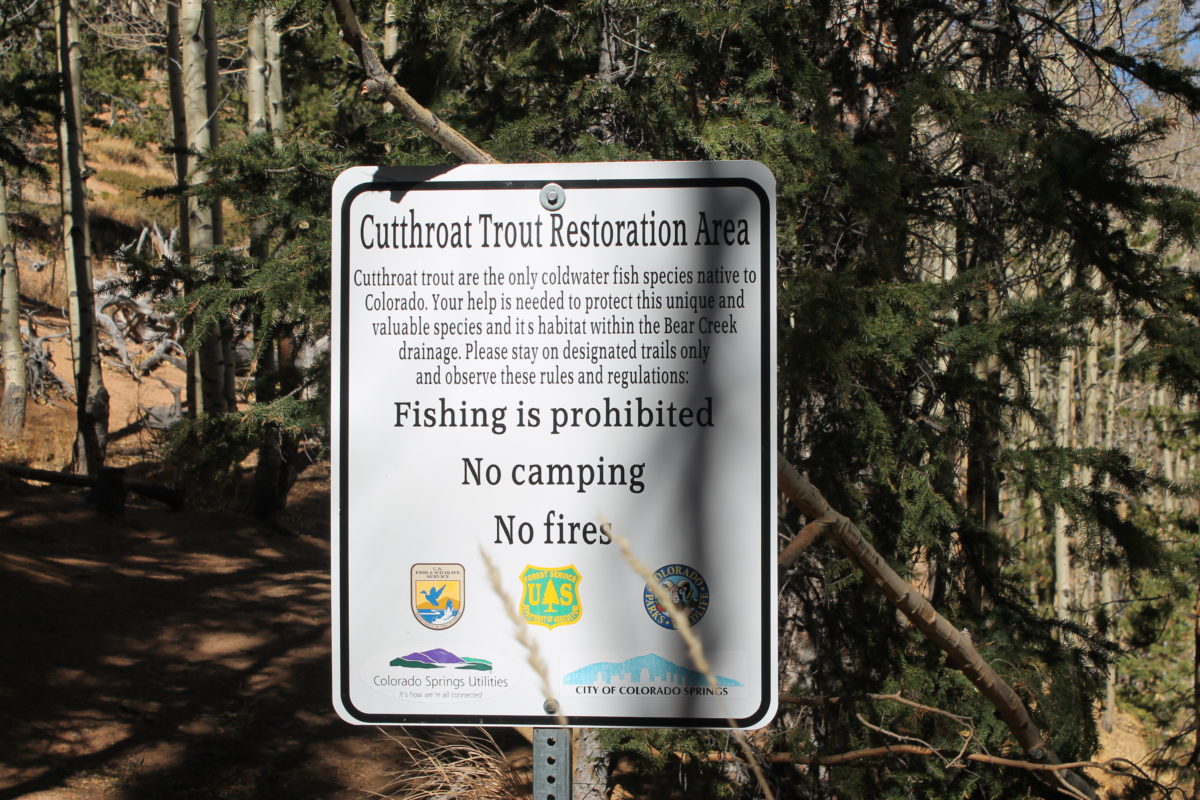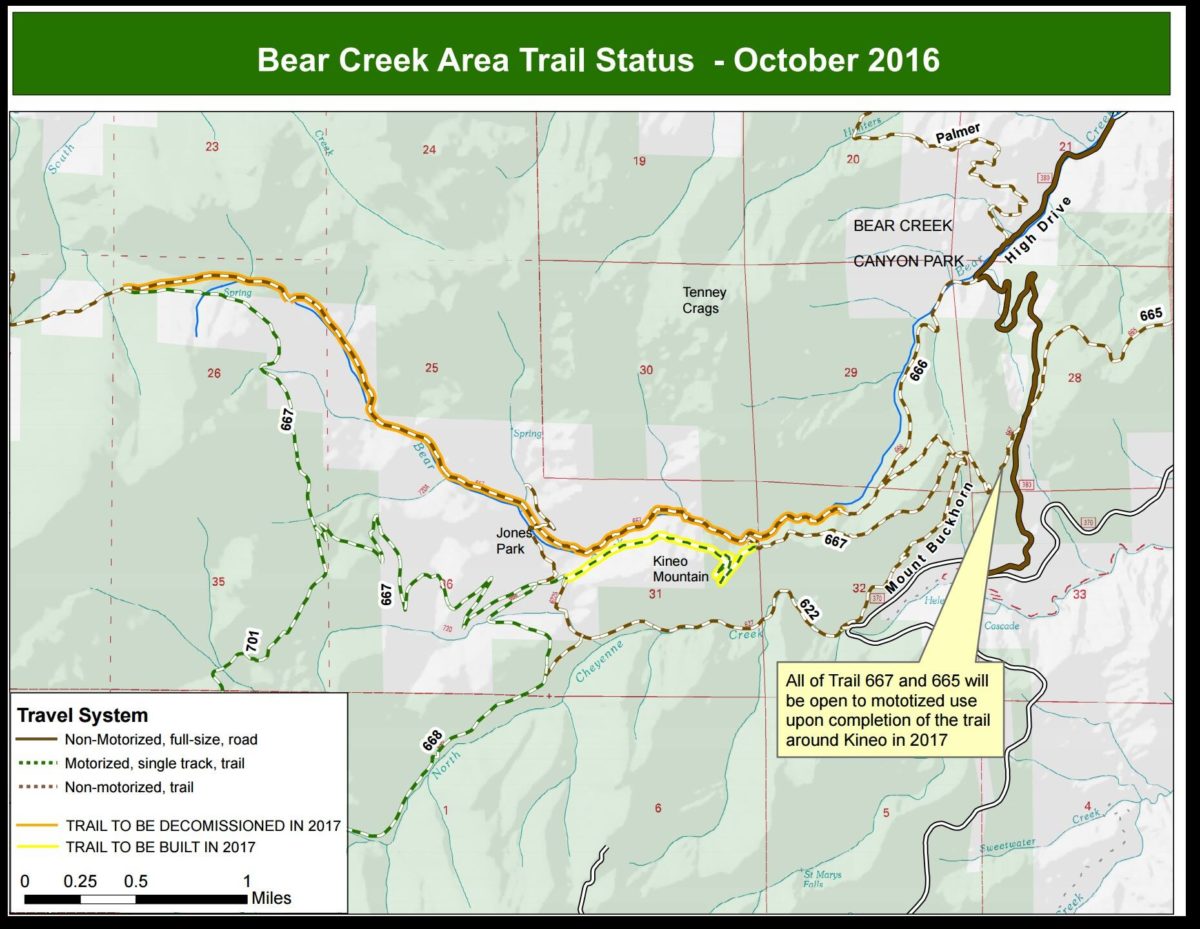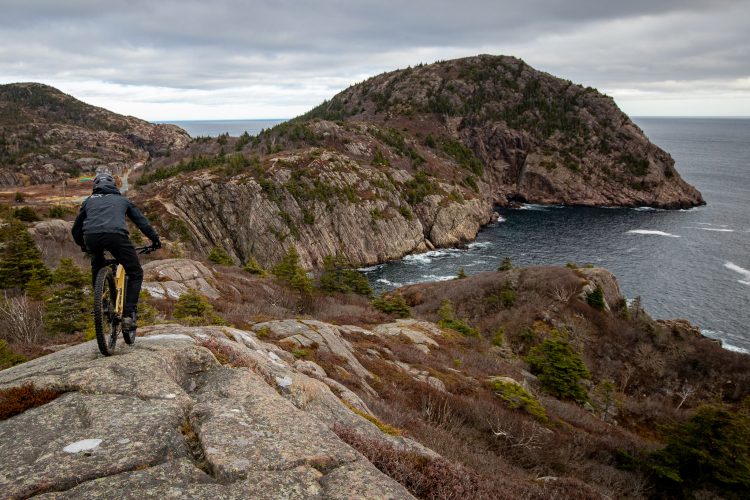
Editor’s Note: John Fisch is an avid backcountry enthusiast who hikes, bikes and backpacks at every opportunity. The trails in this editorial are part of his big backyard. While John is a regular contributor to Singletracks.com, the opinions expressed in this commentary are his alone and do not necessarily represent the opinions of Singletracks.com.
In the spring of 2013, I reported on the pending closure and rerouting of popular trails in the Bear Creek watershed on Colorado Springs’ West side. This move was deemed necessary to protect the only remaining viable population. The whole issue, and the debate surrounding it, was full of ironies, mistrust, volatility, and occasional glimmers of hope. Today, nearly three and a half years later, the picture of the recreational future of the area is beginning to take shape, and few if any who have been in the area since the closures/realignments began are happy; most are completely disgusted.
As one of the area’s premier rides, not just for mountain bikers, but also for motorcyclists who have no other options in the area, any disturbance in the Jones Park trail and the rest of the Bear Creek watershed and its connecting trails was bound to cause unrest, but the result has gone well beyond that, proving unpalatable to all while not even meeting the stated goals of the project, other than reducing the potential sediment loss onto Bear Creek. While I am the first to acknowledge that no solution would have been perfect for any group or approved by all groups, I must say this could have been done so very much better.

(photo: USFS)
Even when I disagree with a position or plan, I can maintain respect and appreciation for it if it is at least consistent, and properly focused on its stated goals. One key problem with the solution as executed to date, is that it is rife with inconsistencies.

(photo: Bastien Donze via Colorado Springs Mountain Biking)
Inconsistency #1: Do we need to keep people out or don’t we?
Area trails were originally closed only to motorcycles. Then the USFS concluded that the sedimentation problem was based on the existence of the trail itself, not user type, and that all user groups, including hikers and bikers, must also be restricted. Now, over three years after that date, nonmotorized users are still allowed. So the question is, do all really need to be restricted, or not? If our very presence was such a threat to the fish, why have we been allowed to traipse through the area for another 40 months? To be fair, the USFS seems to be keeping to their word to have reroutes in place before closing existing trails (well, almost; more on that in the next paragraph), but they have first and foremost said the fish come first, and all other considerations are subordinate. So which is it?

(photo: Bastien Donze via Colorado Springs Mountain Biking)
Inconsistency #2: Is this trail open or not?
New signs appeared early this fall pronouncing closures, but just who is off limits is only partially clear. Signs say “area closed to motor vehicles,” but that is subsequently followed by “foot and horse travel permitted.” This is a little ambiguous to mountain bikers. If cyclists are allowed, why not just say “closed to motor vehicles” and leave it at that? Why go to the trouble to let people know hikers and horses are specifically allowed? As a general rule, if something doesn’t specifically call out bikes as prohibited, then I assume we’re good to go, but that’s not always the case. There are still signs at some Wilderness boundaries that say “no motorized vehicles” with no mention of bikes.

Inconsistency #3: We must accommodate all trail users.
When faced with negative criticism of a new trail (more on that in Problem #2 below), a local USFS ranger explained that the trail must be “wide enough” to accommodate hikers, cyclists, motos, and equestrians. While I understand the need to accommodate all, and applaud honest efforts to do so, this excuse falls flat on three counts. First, the previous trails were not doubletrack wide and regularly carried all those user groups without difficulty. Second, the effect of a hiker and cyclist passing each other requires no more or less width than two cyclists passing each other. Ditto a horse and a hiker or a bike and a motorcycle. Somebody has to yield in any case regardless of whether its two users of the same type or of different types. Third, the reroute is only for limited portions of the trail. The remaining portions retain their previous, narrower singletrack width. What’s the point of widening only part of a route? Anybody troubled by singletrack width will still be faced with that for the rest of the route.

Problem #1: Lack of USFS concern for their constituents.
In my previous article, I noted that the USFS seemed to be managing the process of policy making and trail design in a very open and transparent way, being open to and actually encouraging public input. However, in the final plan, they seem to have discarded all that input. Many residents from all user groups attended public meetings, made inputs, commented via online forums, and offered to physically show decision makers key elements of the topography in question. In the end, the USFS simply gave a no-bid contract to their in house trail builders, Trails Unlimited, who blazed through, apparently without concern for these inputs.

By this summer, this should have been no surprise. When torrential rains ripped through the area a few years ago, trails were closed for safety reasons due to washouts. The closure lasted almost a year. The trails in question crossed multiple management agencies and the USFS stated they couldn’t open their sections until the other agencies, including the City of Colorado Springs, were ready to open theirs. That was a poor excuse, especially after other agencies were ready to go and the USFS still held off. They first said the closures were purely safety driven and had nothing to do with the fish, then later, admitted the fish were in part driving the decision.
Most importantly, nobody was looking to get everything opened at once. All anybody was looking for was one short segment of the area’s most popular trail, Captain Jack’s, to be opened, so as to allow a basic loop. But then the USFS insisted they couldn’t open one trail, or even trail segment, until they were ready to open them all. It would be too much of a management challenge to open things piecemeal. But this segment connected to a non USFS trail on one end which was open, and a city owned road on the other, and the entire segment lies outside the Bear Creek watershed. It could have easily been segregated from the only connector to the still unrepaired area with a single sign no more than two miles from a trailhead.
The rangers I spoke to admitted they had not been in that area and had no plans to go there. They gave a strong impression that they, forest rangers, couldn’t be bothered to actually go into the forest. Funny me, I always thought a love of the outdoors was part of the motivation for becoming a ranger in the first place. Whenever I’ve had jobs that included both office and field work, I made every excuse I could to increase the proportion of time I spent in the field. It’s sad when we have people who never set foot in the areas they manage controlling access, and it’s even sadder when they construct trails that ignore the inputs of those who actually do frequent those areas; those who know every nook and cranny, every form of life that lives there, every bit of topography there

Problem #2: Where am I supposed to go?
Further complicating the “what’s open” question is the fact that there are trails which signs would indicate as open, but beyond the sign, trail obliteration has taken place. Why mark a trail open if it has been rendered unusable downfield from the sign?
The central Jones Park area has always been a slightly confusing conglomeration of intersecting and forking trails, some of which are part of the official USFS system, and some are not. It’s not always clear what the best route–or even the correct route–may be. With the building of new reroutes and the sporadic status of legacy routes, the areas of intersection are now even more confusing. Further complicating things, even to the regular visitor to the area, is the renumbering of segments to conform to the new layout. The USFS has released maps of the proposed final layout, but these maps don’t show all the existing or planned trail numbers, nor do they employ the names commonly used for the trails. As of now, A good deal of route finding is required where little was required in the past.

Problem #3: A poor excuse for a trail.
So what does the new trail actually look like? That varies. In reality, there are three sections that are required to complete the reroute. One has yet to be completed, or at least is so far impossible to find. Of the remaining two, one is long and skirts the southern end of Jones Park, while the other is a shorter connector to the saddle between Captain Jack’s and Buckhorn, which allows for completing the circumnavigation around closed/to-be-closed areas.

The longer of these two, as noted above, was thrown together with little if any concern for providing a good user experience. I say this not as a mountain biker, but as a trail user who also hikes and has been an avid motorcyclist nd equestrian during other points in my life. The trail was machine cut, obviously with a wide blade. It proceeds, for the most part, without any concern for being part of the surroundings. The trail sits on the mountain rather than being part of the mountain. It is unduly wide (previously addressed above), and completely generic. In places, the mountain has been reshaped to accommodate the trail, rather than the trail conforming to the mountain. So much for continuing the backcountry experience. Other than one spot where the trail catches a glimpse of a nice view, it is completely devoid of character. In addition to cycling the area, I hike there. This trail is no more appealing as a hiking trail than as a biking trail. I can safely say that with regard to motos and horses as well. The shorter trail, on the other hand, is reasonably narrow and does a much better job of connecting the two trail segments it joins. This segment was built by the Rocky Mountain Field Institute, not Trails Unlimited.

The orange shows the area main route being decommissioned. The yellow shows that awaiting completion. The switchbacky portion is the disappointing new trail. The connector on the right side between 667 and the decommissioned trail is the more appealing new singletrack.
I was taught that whenever I had a complaint, to also bring a solution. Unfortunately it is too late for a solution to fix what has been done in Jones Park. But I can offer lessons learned from this experience to prevent it from happening again.
Recommendation #1: Use your free resources!
Most notably, the people who live, hike, and ride there. If you’re not going to explore the area yourself, lean on those who do. Your budget may be tight, but people are there to help. You still have the final decision, but make it based on as complete a picture as possible.
Recommendation #2: Don’t automatically settle for the easiest way out.
Study, learn, analyze, apply. Even if you have an in house capability, see if an external provider can produce a better product. Take the long view, not the quick fix (and the “quick fix” here came only after three years of relative inaction; use your time wisely, be aggressive and move forward first). Don’t make excuses; make good things happen. Overcome.
Recommendation #3: Communicate, communicate, communicate!
The last Bear Creek Q&A available from the USFS is from 2014, and much has changed since then. If you know you’re making decisions that will upset constituents, make the decisions known beforehand and give a rational, non-excuse-laden reason why. Don’t hide behind desks and bureaucracy. Update maps with clear markings; give them adequate detail and accurate nomenclature; make them available immediately. In today’s age of instant communication, there is no excuse to not let people know what’s going on and why.
For more information, first hand accounts, and USFS statements, consult the following links:
http://gazette.com/advocates-unhappy-with-trail-reroute-in-bear-creek-watershed/article/1582450
Bear Creek Watershed FAQs
http://www.fs.usda.gov/Internet/FSE_DOCUMENTS/stelprd3792820.pdf
Bear Creek Watershed Restoration Environmental Assessment
http://www.fs.usda.gov/Internet/FSE_DOCUMENTS/stelprd3846425.pdf





















8 Comments
Oct 24, 2016
Oct 24, 2016
For me, two concerns remain: 1. I'm not sure how that will happen where there are those large cutouts/retaining walls as pictured in the article--and how long that will take. 2. If this was the case, why not communicate that from the beginning rather than publicly reporting that the trail had to be that wide? This goes back to my recommendation to communicate more effectively. Accuracy and timeliness of communication go a long way in alleviating unrest.
Oct 25, 2016
Oct 24, 2016
The USFS finds that sediment is harming an endangered fish. They think trails contribute to it. They close the trails to the vehicles that cause the most erosion - motor vehicles. Then they decide that the erosion from the trails alone is still enough of a problem, but they don't want to immediately take away the entire area, so they compromise and let people keep using the trails while the new ones are being built. "...they have first and foremost said the fish come first, and all other considerations are subordinate. So which is it?" This just smacks of nitpicking through USFS statement to find something to call an inconsistency. Don't be a jerk. They obviously decided that leaving the trails open for a little while longer to non-motorized traffic wouldn't kill all the fish quickly, and were willing to rehabilitate the fish habitat a little more slowly than they could have in order to avoid taking away the trails. It doesn't have to be black or white.
Inconsistency #2, also isn't an inconsistency. Yes, yes, they forgot about mountain bikes again. Lots of people do, and things will get better if you are nice about it.
Inconsistency #3 also isn't an inconsistency. When you build new things, you often are working with different design principles and engineering standards than things that were built a long time ago. That is true even when the new things are replacements for the old things. Given the tone of the rest of the post, I am skeptical that there were no users who are happier that the trail is wider (perhaps, motorcycle riders, so they can go faster?).
Telling someone they are being inconsistent is a serious criticism. Synonyms, in this context, would be "unfair" and "hypocritical". I've not discussed the list of "problems", but the "recommendations" are pretty condescending also. If the author approached communication with the USFS in the same way that he tells the story to us, I am not surprised he didn't get very far. Maybe the USFS personnel responsible really were inconsistent and incompetent, but if I were their superior and I read this, I wouldn't put much stock in it.
Oct 25, 2016
Oct 24, 2016
I understand your concerns, and they were mine as well as I initially sat down to put pen to paper for this one.
Please follow the link to my original article about the issue from 2013, and you will see a tone which is much more conciliatory, and actually supportive of the USFS in that article.
I caught a lot of heat from a number of organizations for giving the USFS too much credit and apologizing for them in that original article. Having lived through the last three years, having attempted and watched others more tied in to them try to communicate with them over that period, has confirmed for me confirmed that position for me.
I won't get into a logic debate here. I can tell you that among all users, motorcyclists are the least pleased of all. Having had both knobbies and boots on the ground here through this entire period has allowed me to see the frustration coming from all user groups. The only people who weren't unhappy were the ones who just chose to poach by whatever means they wished regardless of any trail's status at any given time. Most of us aren't willing to do that and try very hard to work in a cooperative environment that serves all interests to the best extent possible.
Oct 24, 2016
Oct 25, 2016